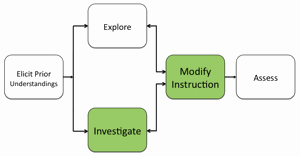Greenhouse Effect Lab
Students will understand the importance of greenhouse gases in our atmosphere and that excess CO2 intensifies the greenhouse effect.

Lab Overview:
In this laboratory investigation, students investigate the ability of an intensified CO2 atmosphere to absorb thermal (heat) energy. They will compare differences in the heat absorption (changes in temperature) in an unaltered air sample to an intensified CO2 atmosphere.
1. Begin class by having students think about and discuss why the inside of a car gets hot during a summer day. During discussion, emphasize that energy from the sun (light energy) passes through the car’s window. This infrared energy is converted to thermal (heat) energy. The temperature inside the car rises quickly and stays warm for an extended period because the car’s windows are insulators. The heat energy inside the car cannot reradiate or pass through the windows. The absorption of infrared energy in the car is similar to the role of greenhouse gases in our atmosphere.
2. To begin the laboratory activity, divide students into groups of four.
3. Distribute a Greenhouse Effect Laboratory Guide and an Investigation Sheet to each student.
4. Instruct students to read the background information section in their Greenhouse Effect Laboratory Guide.
5. Ask students to discuss and summarize what they read. Ask students how they think the greenhouse effect is related to climate change.
6. Inform students that they will conduct an experiment to investigate the impact of the greenhouse effect on atmospheric temperatures.
7. Instruct students to read through the laboratory procedures and summarize the key procedural steps. You may wish to explicitly model each procedural step with your students.
Implementation Suggestion:
- It is recommended that all materials are set up at each laboratory station for student use.
8. Instruct students to assemble atmosphere containers, placing probes or thermometers into the containers.
9. Instruct students to add the baking soda and liquids to the atmosphere containers. Instruct students to seal the containers immediately after the liquid is added and then swirl the mixture for 15 seconds.
Important Note: It is important that students seal their containers immediately after adding the liquid and then swirl the mixture for 15 seconds in order to gather accurate data for the CO2 container.
10. Instruct students to position the lamp above the containers as shown in the procedure.
11. Ask students to predict which atmosphere container will heat the fastest and which will reach the highest temperature. Instruct students to write their predictions on their Greenhouse Effect Lab Investigation Sheet.
12. Instruct students to begin gathering data and to record their findings as instructed in the laboratory procedure.
13. Instruct students to complete the Greenhouse Effect Lab Analysis section on their Investigation Sheet.
14. Ask student groups to share their results with the class, and to provide evidence to support their conclusions. Review analysis question responses.
15. Review the lesson concepts at the conclusion of the activity. Ensure that students understand that greenhouse gases are an important part of our atmosphere. They provide atmospheric temperature regulation that enables Earth to be a livable planet. There are both natural and anthropogenic causes for increases in greenhouse gases. Imbalance or excess in greenhouse gas levels can lead to long-term increases in atmospheric temperature.
Implementation Suggestion:
- With lower ability level students, you may wish to have students read the background information section and demonstrate the laboratory procedures the day before conducting the laboratory procedures.
Materials Needed:
In this laboratory investigation, students investigate the ability of an intensified CO2 atmosphere to absorb thermal (heat) energy. They will compare differences in the heat absorption (changes in temperature) in an unaltered air sample to an intensified CO2 atmosphere.
1. Begin class by having students think about and discuss why the inside of a car gets hot during a summer day. During discussion, emphasize that energy from the sun (light energy) passes through the car’s window. This infrared energy is converted to thermal (heat) energy. The temperature inside the car rises quickly and stays warm for an extended period because the car’s windows are insulators. The heat energy inside the car cannot reradiate or pass through the windows. The absorption of infrared energy in the car is similar to the role of greenhouse gases in our atmosphere.
2. To begin the laboratory activity, divide students into groups of four.
3. Distribute a Greenhouse Effect Laboratory Guide and an Investigation Sheet to each student.
4. Instruct students to read the background information section in their Greenhouse Effect Laboratory Guide.
5. Ask students to discuss and summarize what they read. Ask students how they think the greenhouse effect is related to climate change.
6. Inform students that they will conduct an experiment to investigate the impact of the greenhouse effect on atmospheric temperatures.
7. Instruct students to read through the laboratory procedures and summarize the key procedural steps. You may wish to explicitly model each procedural step with your students.
Implementation Suggestion:
- It is recommended that all materials are set up at each laboratory station for student use.
8. Instruct students to assemble atmosphere containers, placing probes or thermometers into the containers.
9. Instruct students to add the baking soda and liquids to the atmosphere containers. Instruct students to seal the containers immediately after the liquid is added and then swirl the mixture for 15 seconds.
Important Note: It is important that students seal their containers immediately after adding the liquid and then swirl the mixture for 15 seconds in order to gather accurate data for the CO2 container.
10. Instruct students to position the lamp above the containers as shown in the procedure.
11. Ask students to predict which atmosphere container will heat the fastest and which will reach the highest temperature. Instruct students to write their predictions on their Greenhouse Effect Lab Investigation Sheet.
12. Instruct students to begin gathering data and to record their findings as instructed in the laboratory procedure.
13. Instruct students to complete the Greenhouse Effect Lab Analysis section on their Investigation Sheet.
14. Ask student groups to share their results with the class, and to provide evidence to support their conclusions. Review analysis question responses.
15. Review the lesson concepts at the conclusion of the activity. Ensure that students understand that greenhouse gases are an important part of our atmosphere. They provide atmospheric temperature regulation that enables Earth to be a livable planet. There are both natural and anthropogenic causes for increases in greenhouse gases. Imbalance or excess in greenhouse gas levels can lead to long-term increases in atmospheric temperature.
Implementation Suggestion:
- With lower ability level students, you may wish to have students read the background information section and demonstrate the laboratory procedures the day before conducting the laboratory procedures.
Materials Needed:
Handouts
(1) Greenhouse Effect Lab Teacher Guide (PDF / MS Word)
(2) Greenhouse Effect Laboratory Guide (PDF / MS Word)
(3) Greenhouse Effect Lab Investigation Sheet (PDF / MS Word)
Assessment Information
